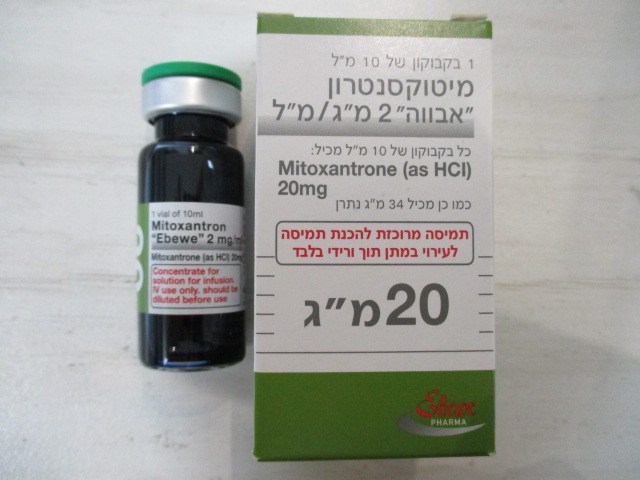Quest for the right Drug

מיטוקסנטרון "אבווה" 2 מ"ג/מ"ל MITOXANTRON "EBEWE" 2 MG/ML (MITOXANTRONE AS HYDROCHLORIDE)
תרופה במרשם
תרופה בסל
נרקוטיקה
ציטוטוקסיקה
צורת מתן:
תוך-ורידי : I.V
צורת מינון:
תרכיז להכנת תמיסה לאינפוזיה : CONCENTRATE FOR SOLUTION FOR INFUSION
עלון לרופא
מינוניםPosology התוויות
Indications תופעות לוואי
Adverse reactions התוויות נגד
Contraindications אינטראקציות
Interactions מינון יתר
Overdose הריון/הנקה
Pregnancy & Lactation אוכלוסיות מיוחדות
Special populations תכונות פרמקולוגיות
Pharmacological properties מידע רוקחי
Pharmaceutical particulars אזהרת שימוש
Special Warning עלון לרופא
Physicians Leaflet
Posology : מינונים
4.2 Posology and Method of Administration Advanced Breast Cancer, Non-Hodgkin’s Lymphoma Single-Agent Dosage: The recommended initial dosage of mitoxantrone used as a single agent is 14 mg/m2 of body surface area, given as a single intravenous dose which may be repeated at 21- day intervals. A lower initial dosage (12 mg/m2) is recommended in patients with inadequate bone marrow reserves, e.g., due to prior chemotherapy or poor general condition. Dosage modification and the timing of subsequent dosing should be determined by clinical judgement depending on the degree and duration of myelosuppression. For subsequent courses the prior dose can usually be repeated if white blood cell and platelet counts have returned to normal levels after 21 days. The following table is suggested as a guide to dosage adjustment, in the treatment of advanced breast cancer and non-Hodgkin’s lymphoma, according to haematological nadir (which usually occurs about 10 days after dosing). Nadir After Prior dose WBC Platelets Time to Subsequent dose after adequate (per mm3) (per mm3) recovery haematological recovery Repeat prior dose after recovery, or increase by ≤21 days 2 mg/m2 if myelosuppression is not considered >1,500 AND >50,000 adequate Withhold until recovery, then repeat prior >1,500 AND >50,000 >21 days dose Decrease by 2 mg/m2 from prior dose after <1,500 OR <50,000 Any duration recovery Combination Therapy: Mitoxantrone has been given as part of combination therapy. In advanced breast cancer, combinations of mitoxantrone with other cytotoxic agents, including cyclophosphamide and 5-fluorouracil, or methotrexate and mitomycin C, have been shown to be effective. Reference should be made to the published literature for information on dosage modifications and administration. Mitoxantrone has also been used in various combinations for non-Hodgkin’s lymphoma; however, data are presently limited and specific regimens cannot be recommended. As a guide, when mitoxantrone is used in combination chemotherapy with another myelosuppressive agent, the initial dose of mitoxantrone should be reduced by 2-4 mg/m2 below the doses recommended for single-agent usage; subsequent dosing, as outlined in the table above, depends on the degree and duration of myelosuppression. Acute Myeloid Leukaemia Single-Agent Dosage in Relapse: The recommended dosage for remission induction is 12 mg/m2 of body surface area, given as a single intravenous dose daily for five consecutive days (total of 60 mg/m2). In clinical studies with a dosage of 12 mg mitoxantrone/m2 daily for 5 days, patients who achieved a complete remission did so as a result of the first induction course. Combination Therapy: Mitoxantrone has been used in combination regimens for the treatment of acute non-lymphocytic leukaemia (ANLL). Most clinical experience has been with mitoxantrone combined with cytosine arabinoside. This combination has been used successfully for primary treatment of ANLL as well as in relapse. An effective regimen for induction in previously untreated patients has been mitoxantrone 10-12 mg/m2 IV for 3 days combined with cytosine arabinoside 100 mg/m2 IV for 7 days (by a continuous infusion). This is followed by second induction and consolidation courses as thought appropriate by the treating clinician. In clinical studies, duration of therapy in induction and consolidation courses with mitoxantrone has been reduced to 2 days and that of cytosine arabinoside to 5 days. However, modification of the above regimen should be carried out by the treating clinician depending on individual patient factors. If severe or life-threatening non-haematological toxicity is observed during the first induction course, the second induction course should be withheld until the toxicity clears. Reference should be made to the published literature for information on specific dosage regimens. Children As experience with mitoxantrone in paediatric leukaemia is limited, dosage recommendations in this patient population cannot be given at present. Hormone-Refractory Prostate Cancer Based on the data from two Phase III comparative trials of mitoxantrone plus corticosteroids versus corticosteroids alone, the recommended dosage of mitoxantrone is 12 to 14 mg/m2 given as a short intravenous infusion every 21 days. Multiple Sclerosis The recommended dosage of mitoxantrone hydrochloride is 12 mg/m2 body surface area given as a short (approx. 5-15 minutes) intravenous infusion every 3 months. Evaluation of the left ventricular ejection fraction (LVEF) (by echocardiogram or MUGA) is recommended prior to administration of the initial dose of mitoxantrone hydrochloride (see Special Warnings and Precautions for Use). Complete blood counts, including platelets, should be monitored prior to each course of mitoxantrone hydrochloride and in the event that signs or symptoms of infection develop (see Special Warnings and Precautions for Use). Women with multiple sclerosis who are biologically capable of becoming pregnant should have a pregnancy test, even if they are using birth control, and the results should be known before receiving each dose of mitoxantrone hydrochloride.

שימוש לפי פנקס קופ''ח כללית 1994
לא צוין
תאריך הכללה מקורי בסל
01/01/1995
הגבלות
תרופה מוגבלת לשימוש בבתי חולים או אשפוז יום
מידע נוסף
